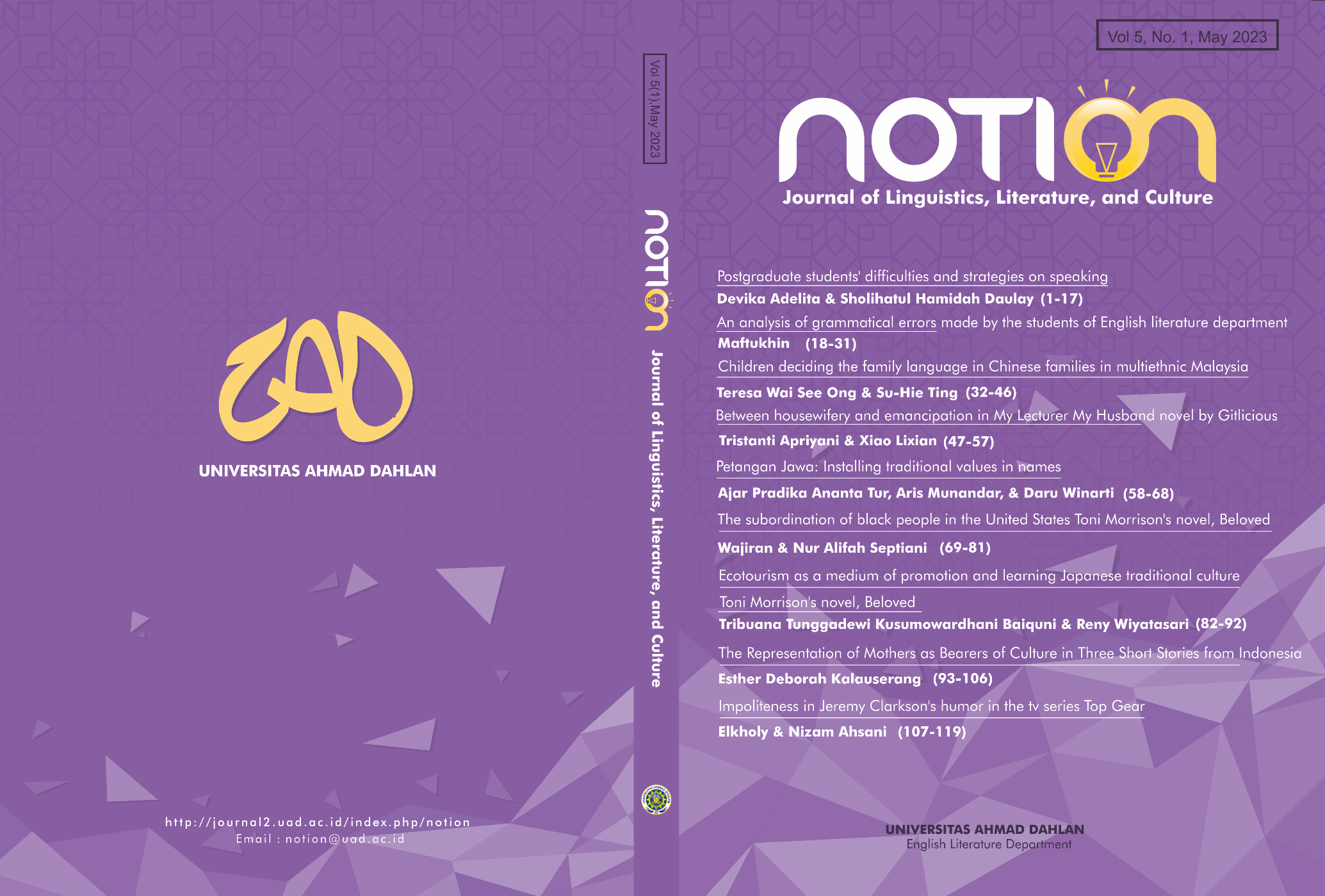An Analysis of Grammatical Errors Made by the Students of English Literature Department
DOI:
https://doi.org/10.12928/notion.v5i1.7404Keywords:
error analysis, grammatical analysis, intralingual transfer, interlingual transferAbstract
This research aims to identify grammatical errors made by the students of the English Literature department of Universitas Ahmad Dahlan and to describe the process of the occurrence of grammatical errors. This research is a descriptive study that uses a qualitative method. The data are the writing assignments of second-semester students of the English Literature department of Universitas Ahmad Dahlan of the 2018 - 2019 academic year. The researcher read the writings of the students, then wrote and classified the errors made by the students into types of errors due to interlingual and intralingual transfers. This research uses the descriptive analysis method to describe the types of errors. The results show that the types of errors due to the interlingual and intralingual transfer are omission errors, addition errors, misordering errors, and misformation errors. The results of this study are expected to be the basis for minimizing grammatical errors in the English teaching and learning process, especially for writing in English. The results can also be used as a basis for compiling course materials, writing textbooks or modules, especially for making exercises that focus on errors that often occur, to prevent similar errors that will occur in the future.
References
Andrian. (2015) An Error Analysis of EFL Students’ English Writing. English Education Journal, 6 (4), p. 511-523. http://www.jurnal.unsyiah.ac.id/EEJ/article/view/2859
Arikunto, S. (2013). Prosedur Penelitian. Jakarta: Rineka Cipta.
Brown, H. D. (2000). Principles of Language Learning and Teaching (4th Ed.). NewYork: Addison, Wesley, Longman, Inc.
Brown, H. D. (2014). Principles of Language Learning and Teaching. (6th Ed.). NewYork: Pearson Education, Inc.
Crystal, D. (2008). A dictionary of linguistics and phonetics (6th ed.). Oxford: Blackwell Publishing.
Dullay, H., Marina Burt, Stephen Krashen. (1982). Language Two. New York: Oxford University Press.
Fitria & Tur, A.P.A. (2019). From Abstract to Concrete: Associating the Users’ Tweets on “Success”. Indonesian Journal of EFL and Linguistics, Vol. 4(2), p. 121-134. https://pdfs.semanticscholar.org/3af5/b3f2fe46421b4da5819ccb6c799aa9d9f6fa.pdf
James, Carl. (2013). Errors in Language Learning and Use. New York : Routledge.
Ma’mun, N. (2016). The grammatical errors on the paragraph writings. Vision: Journal for Language and Foreign Language Learning, 5(1), p. 95-131. http://dx.doi.org/10.21580/vjv5i.1862
Moleong, Lexy J. (2017). Metodologi Penelitian Kualitatif. Bandung: Penerbit PT Remaja Rosdakarya.
Setyawati, Nanik. (2013). Analisis Kesalahan Berbahasa Indonesia Teori dan Praktik. Surakarta: Yuma Pustaka.
Subroto, D. E. (2007). Pengantar Metoda Penelitian Struktural. Surakarta: LPP UNS dan UNS PRESS.
Sudaryanto.(2018). Metode dan Aneka Teknik Analisis Bahasa. Yogyakarta: Duta Wacana University Press.
Sugeng, B. (2016). Common grammatical errors in the use of English as a foreign language: a case in students’ undergraduate theses. Litera, Vol. 15(1), p. 111-119. https://doi.org/10.21831/ltr.v15i1.10415
Sutopo, H. (2002). Pengantar Penelitian Kualitatif (Dasar-dasar Teoritis dan Praktis). Surakarta: Universitas Sebelas Maret Press.
Tur, A.P.A. (2019). Patterns of linguistics features in private chat of social media account leading a person to be a victim of a cybercrime. LEKSIKA, Vol. 13(1), p. 29-38. https://jurnalnasional.ump.ac.id/index.php/LEKSIKA/article/view/3858/2423
Tur, A.P.A. (2022). Trend of having more name parts in homogenous community. BAHASTRA, Vol. 42(1), p. 17-25. http://journal1.uad.ac.id/index.php/BAHASTRA/article/view/66/18
Zubaidi. (2013) Analisis Jenis dan Frekuensi Kesalahan Gramatikal Bahasa Inggris Tulis Mahasiswa. Jurnal Linguistik Terapan (JLT) Vol. 2(2), p. 62-71. http://jurnal.polinema.ac.id/index.php/jlt/article/view/253
Downloads
Published
Issue
Section
License
Copyright (c) 2023 Maftukhin

This work is licensed under a Creative Commons Attribution 4.0 International License.
Authors who publish their articles in NOTION: journal of Linguistics, Literature, and Culture agree to the following terms:
- Authors retain the copyright and grant the journal right of first publication with the work simultaneously licensed under a Creative Commons Attribution 4.0 International License that allows others to share the work with an acknowledgement of the work's authorship and initial publication in this journal.
- Authors are able to enter into separate, additional contractual arrangements for the non-exclusive distribution of the journal's published version of the work (e.g., post it to an institutional repository or publish it in a book), with an acknowledgement of its initial publication in this journal.
- Authors are permitted and encouraged to post their work online (e.g., in institutional repositories or on their website) prior to and during the submission process, as it can lead to productive exchanges, as well as earlier and greater citation of published work.





